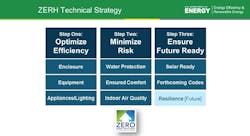3 Strategies To Building Net Zero Energy Homes
Building zero energy homes may be a hot topic, but for many builders, this subject raises plenty of questions.
Even those who are interested in these ultra energy efficient homes wonder if there’s enough demand in their market (32%), think such building practices may be cost-prohibitive (29%), believe they don’t know how to construct such homes (21%), and lastly, worry about marketing and selling zero energy homes effectively (6%), according to a poll of UTOPIA webinar participants.
The good news is that building zero energy homes may not be as difficult or as costly as many builders think. “This is so ready for mainstream builders,” says Sam Rashkin, chief architect of the Building Technologies Office at the U.S. Department of Energy. “These are not exotic, crazy, eclectic choices you have to make. This is mainstream product and mainstream equipment to get you [to zero energy homes].”
He and others shared their perspectives and advice during “Best Practices for Building Net Zero Ready Homes,” a November 2020 webinar featuring Rashkin; Dave Everson, owner and CEO of Mandalay Homes in Arizona; and Chad Gillespie, senior manager, performance construction, for Mitsubishi Electric. David Barista, UTOPIA’s content director, moderated the discussion.
Here are three takeaways from their talk.
1. You can stage your shift to building zero energy homes.
Rashkin suggests starting with optimizing efficiency, which covers the building envelope, equipment, and the appliances and lighting. Step two is minimizing risk through indoor air quality, comfort, and water protection.
Lastly, make your homes “zero energy ready” by making it easy to add and connect solar when the homeowner is ready to invest in renewables.
2. “Pick your target.”
That advice comes from Everson, who recommends builders choose a HERS score, run your existing homes through energy modeling, and then “have your rater experiment with you” to see how you might achieve your desired energy efficiency. “
It’s a recipe” based on climate zone, use of fuel, and other enhancements, says Everson, whose last 500 homes have averaged a HERS rating of 42. Mandalay’s last 100 homes, which are all electric and incorporate renewable energy, average a HERS score of 27.
3. Do your load calculations with care.
“Builders sometimes listen to their HVAC installer … and they’ve made some assumptions that could really change the performance of the house,” cautions Gillespie. He urges builders to consider a home’s location, approximate area, orientation, mechanical systems, and glass and roof specs when calculating a home’s heating/cooling load.
Once those are done, look closely at the numbers and see if you can make any adjustments to improve the home’s energy efficiency with air sealing, window glazing, putting ductwork in conditioned spaces, or other strategies. Even seemingly minor changes could affect a home’s heating/cooling load, according to Gillespie, who noted how rotating a house 90 degrees reduced its load by 2 tons.
Want to learn more about building zero energy homes? Watch our full one-hour webinar on demand: “Best Practices for Building Net Zero Ready Homes.”
RELATED: How Mandalay Homes Gets to Net Zero


